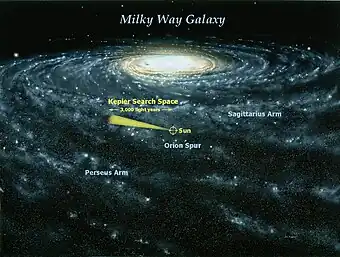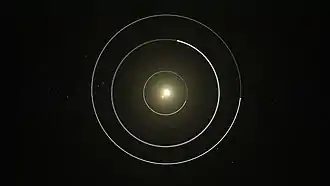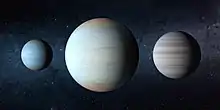| Observation data Epoch J2000 Equinox J2000 | |
|---|---|
| Constellation | Cygnus |
| Right ascension | 19h 41m 11.49832s[1] |
| Declination | +46° 55′ 13.7073″[1] |
| Apparent magnitude (V) | 15.4[2] |
| Characteristics | |
| Evolutionary stage | Main sequence |
| Spectral type | G6V / M4V |
| Astrometry | |
| Proper motion (μ) | RA: −3.383 mas/yr[1] Dec.: −10.212 mas/yr[1] |
| Parallax (π) | 0.9540 ± 0.0208 mas[1] |
| Distance | 3,420 ± 70 ly (1,050 ± 20 pc) |
| Orbit[3] | |
| Primary | Kepler-47A |
| Companion | Kepler-47B |
| Period (P) | 7.4483648+0.0000038 −0.0000270 d |
| Semi-major axis (a) | 0.08145+0.00036 −0.00037 AU |
| Eccentricity (e) | 0.0288+0.0015 −0.0013 |
| Inclination (i) | 89.613+0.045 −0.040° |
| Argument of periastron (ω) (secondary) | 226.3+2.8 −2.6° |
| Details[4][3] | |
| Kepler-47A | |
| Mass | 0.957+0.013 −0.015 M☉ |
| Radius | 0.936±0.005 R☉ |
| Luminosity | 0.840 ± 0.067 L☉ |
| Surface gravity (log g) | 4.488 ± 0.01 cgs |
| Temperature | 5636 ± 100 K |
| Metallicity [Fe/H] | −0.25 ± 0.08 dex |
| Rotational velocity (v sin i) | 4.1+0.5 −0.35 km/s |
| Age | 4–5 Gyr |
| Kepler-47B | |
| Mass | 0.342±0.003 M☉ |
| Radius | 0.338±0.002 R☉ |
| Luminosity | 0.014 ± 0.002 L☉ |
| Surface gravity (log g) | 4.9073 ± 0.0067 cgs |
| Temperature | 3357 ± 100 K |
| Age | 4–5 Gyr |
| Other designations | |
| Database references | |
| SIMBAD | data |
| KIC | data |
Kepler-47 is a binary star system in the constellation Cygnus located about 3,420 light-years (1,050 parsecs) away from Earth. The stars have three exoplanets, all of which orbit both stars at the same time, making this a circumbinary system. The first two planets announced are designated Kepler-47b, and Kepler-47c, and the third, later discovery is Kepler-47d. Kepler-47 is the first circumbinary multi-planet system discovered by the Kepler mission.[5] The outermost of the planets is a gas giant orbiting within the habitable zone of the stars.[6] Because most stars are binary, the discovery that multi-planet systems can form in such a system has impacted previous theories of planetary formation.[7][5]
A group of astronomers led by Jerome Orosz at San Diego State University, including astronomers from Tel-Aviv University in Israel, discovered the planetary system via NASA's Kepler space telescope in 2012.[8] In November 2013, evidence of a third planet orbiting between the planets b and c, Kepler-47d, was announced.[9] Later analyses of transit data from the Kepler space telescope confirmed the existence of Kepler-47d.[10]
Nomenclature and history

Prior to Kepler observation, Kepler-47 had the 2MASS catalogue number 2MASS J19411149+4655136. In the Kepler Input Catalog it has the designation of KIC 10020423, and when it was found to have transiting planet candidates it was given the Kepler object of interest number of KOI-3154.[4]
Planetary candidates were detected around the pair of stars by NASA's Kepler Mission, a mission tasked with discovering planets in transit around their stars.[11] The discoverers referred the pair of stars as Kepler-47, which is the normal procedure for naming stars with exoplanets discovered by the spacecraft.[4] Hence, this is the name used by the public to refer to the pair of stars and its planets. Candidate planets that are associated with stars studied by the Kepler Mission are known as Kepler objects of interest (KOI) and are assigned the designations ".01", ".02", ".03" etc. after the star's name, in the order of discovery.[12] If planet candidates are detected simultaneously, then the ordering follows the order of orbital periods from shortest to longest.[12] Following these rules, two candidate planets were detected, with orbital periods of 49.51 and 303.158 days.[4] Upon confirmation, the planets of Kepler-47 are designated by letters, with the first planet being designated b and so on. The ordering of designations are identical to the latter designations for candidate planets.[13]
Stellar characteristics
Kepler-47 is a binary star system located about 1,055 parsecs (3,440 light-years) away from Earth.[14] The binary system is composed of a G-type main sequence star (Kepler-47A) and a red dwarf star (Kepler-47B). The stars orbit each other around their barycenter, or center of mass between them, completing one full orbit every 7.45 days.[4] The stars orbit their barycenter from a distance of about 0.084 AU.[4] The stars have 104% and 35% of the Sun's mass, and 96% and 35% of the Sun's radius, respectively.[4] They have surface temperatures of 5636 K and 3357 K.[4] Based on the stellar characteristics and orbital dynamics, an estimated age of 4–5 billion years for the system is possible.[4] In comparison, the Sun is about 4.6 billion years old,[15] and has a temperature of 5772 K.[16]
The primary star is somewhat metal-poor, with a metallicity ([Fe/H]) of about −0.25, or about 56% of the amount of iron and other heavier metals found in the Sun.[4] Both of the stars' luminosities are typical for their kind, with a luminosities of around 84% and 1% of that of the solar luminosity, respectively.[4]
The apparent magnitude of the star system, or how bright it appears from Earth's perspective, is about 15.4.[2] It is too dim to be seen with the naked eye, which can typically detect objects with a magnitude less than 6.5.[17]
Planetary system

Prior to the discovery of the Kepler-47 planetary system by Jerome Orosz, his colleagues, as well as astronomers from Tel-Aviv University in 2012,[8] most scientists thought that binary stars with multiple planets could not exist.[5] It was believed that gravitational perturbations caused by the orbiting parent stars would cause any circumbinary planets to collide with each other or be ejected out of orbit, either into one of the parent stars or away from the system.[5] However, this discovery demonstrates that multiple planets can form around binary stars, even in their habitable zones; and while the planets in the Kepler-47 system are unlikely to harbor life, other planets orbiting around binary star systems may be habitable and could support life.[5] Because most stars are binary, the discovery that multi-planet systems can form in such a system has impacted previous theories of planetary formation, and could provide more opportunities for finding potentially habitable exoplanets.[7][5]
The binary system is known to host three planets, all orbiting close to each other and larger than Earth, with no solid surface.[3] All three of the planets in the Kepler-47 system have a very low density, less than that of Saturn.[18][19] The densities of the planets are estimated to be around 0.26 g/cm3 to 0.68 g/cm3.[3] The low densities of the planets are unusual for their relatively mild temperatures; planets with such low densities are typically hot jupiters that orbit close to their host stars, being known as so-called puffy planets.[19][18] Temperate low-density planets like these are thought to be uncommon.[18]
| Companion (in order from star) |
Mass | Semimajor axis (AU) |
Orbital period (days) |
Eccentricity | Inclination | Radius |
|---|---|---|---|---|---|---|
| b | 2.07+23.70 −2.07 M🜨 |
0.2877+0.0014 −0.0011 |
49.4643+0.0081 −0.0074 |
0.0210+0.0025 −0.0022 |
89.752+0.063 −0.045° |
3.05±0.04 R🜨 |
| d | 19.02+23.84 −11.67 M🜨 |
0.6992+0.0031 −0.0033 |
187.366+0.069 −0.051 |
0.024+0.025 −0.017 |
90.395+0.009 −0.012° |
7.04+0.66 −0.49 R🜨 |
| c | 3.17+2.18 −1.25 M🜨 |
0.9638+0.0041 −0.0044 |
303.227+0.062 −0.027 |
0.044+0.029 −0.019 |
90.1925+0.0055 −0.0042° |
4.65+0.09 −0.07 R🜨 |

Kepler-47b
Kepler-47b is a Neptune class planet and the innermost planet of the Kepler-47 system. It resides close to its parent stars, at a distance of 0.2956 AU.[4][3] It completes one full orbit around its parent stars in less than 50 days.[5] The equilibrium temperature of Kepler-47b is 442 K, therefore being inhospitable to life.[18] Due to the high equilibrium temperature of Kepler-47b, methane gas in its atmosphere would be broken into other compounds, leading to a thick haze that would cover the planet's atmosphere.[5] It is the smallest planet of the Kepler-47 system, being 3.1 times the size of Earth.[18]
Kepler-47c
The second planet discovered, Kepler-47c, is a Neptune class planet and the outermost planet, orbiting its parent stars from a distance of 0.989 AU, nearly the distance from Earth to the Sun.[4] It completes one full orbit around its parent stars in about 300 days.[5] Kepler-47c is situated within the habitable zone, with an equilibrium temperature of 241 K.[5][18] The radius of Kepler-47c is 4.7 times that of Earth, comparable in size to Neptune.[5][18] Although it is assumed Kepler-47c is not capable of harboring life, it could possibly have a dense atmosphere of water vapor.[5]
Kepler-47d

The most recently discovered planet in the system, Kepler-47d, was announced as being discovered by astronomer Jerome Orosz and his colleagues at San Diego State University in November 2013.[9][18] From transit data of the Kepler-47 system from the Kepler space telescope, Orosz's team had noticed one orphan transit signal that lasted for 4.15 hours,[4][20] and was not attributed to the two previously known planets.[18][9] Due to the weak transit signals of Kepler-47d, it was not detected earlier in 2012.[18][3] Only one noticeable transit of Kepler-47d has been detected,[20] thus an additional transit of the planet was needed to confirm its existence.[10] From dynamical simulations, the orbit of Kepler-47d was shown to precess over time, resulting in a four-year period without transits from Kepler-47d.[4][9] Later studies of the Kepler-47 system led to the confirmation of Kepler-47d, which was announced in April 2019.[10] The discovery of Kepler-47d was unexpected for Orosz's team, as they had expected to find additional planets with more distant orbits.[18][19] Kepler-47d is the largest planet of the Kepler-47 system, with a radius at least 7 times the radius of Earth (almost the size of Saturn, though its mass is comparable to that of Neptune).[3] It orbits between the planets Kepler-47b and c at a distance of about 0.7 AU, completing an orbit every 187.35 days.[9][21] Its equilibrium temperature is around 283 K.[18]
See also
- Kepler mission
- NN Serpentis, an eclipsing binary system hosting two exoplanets
- Lists of exoplanets
- List of extrasolar planet firsts, including Kepler-47 with the most circumbinary planets
References
- 1 2 3 4 5 Vallenari, A.; et al. (Gaia collaboration) (2023). "Gaia Data Release 3. Summary of the content and survey properties". Astronomy and Astrophysics. 674: A1. arXiv:2208.00211. Bibcode:2023A&A...674A...1G. doi:10.1051/0004-6361/202243940. S2CID 244398875. Gaia DR3 record for this source at VizieR.
- 1 2 "UCAC4 685-070595". VizieR. 2012. Retrieved 16 April 2019.
- 1 2 3 4 5 6 7 8 Orosz, Jerome A.; Welsh, William F.; Haghighipour, Nader; Quarles, Billy; Short, Donald R.; Mills, Sean M.; Sutyal, Suman; Torres, Guillermo; Agol, Eric; Fabrycky, Daniel C. (16 April 2019). "Discovery of a Third Transiting Planet in the Kepler-47 Circumbinary System". The Astronomical Journal. 157 (5): 174. arXiv:1904.07255. Bibcode:2019AJ....157..174O. doi:10.3847/1538-3881/ab0ca0. S2CID 118682065.
- 1 2 3 4 5 6 7 8 9 10 11 12 13 14 15 Orosz, Jerome A.; Welsh, William F.; Carter, Joshua A.; Fabrycky, Daniel C.; Cochran, William D.; Endl, Michael; Ford, Eric B.; Haghighipour, Nader; MacQueen, Phillip J.; Mazeh, Tsevi; Sanchis-Ojeda, Roberto; Short, Donald R.; Torres, Guillermo; Agol, Eric; Buchhave, Lars A.; Doyle, Laurance R.; Isaacson, Howard; Lissauer, Jack J.; Marcy, Geoffrey W.; Shporer, Avi; Windmiller, Gur; Barclay, Thomas; Boss, Alan P.; Clarke, Bruce D.; Fortney, Jonathan; Geary, John C.; Holman, Matthew J.; Huber, Daniel; Jenkins, Jon M.; et al. (2012). "Kepler-47: A Transiting Circumbinary Multi-Planet System". Science. 337 (6101): 1511–4. arXiv:1208.5489. Bibcode:2012Sci...337.1511O. doi:10.1126/science.1228380. PMID 22933522. S2CID 44970411.
- 1 2 3 4 5 6 7 8 9 10 11 12 "NASA's Kepler Discovers Multiple Planets Orbiting a Pair of Stars". exoplanets.nasa.gov. NASA. 28 August 2012. Archived from the original on 31 October 2012. Retrieved 2 September 2012.
Kepler mission has discovered multiple transiting planets orbiting two suns for the first time
- ↑ Orosz, Jerome A.; Welsh, William F.; Carter, Joshua A.; Fabrycky, Daniel C.; Cochran, William D.; Endl, Michael; Ford, Eric B.; Haghighipour, Nader; MacQueen, Phillip J.; Mazeh, Tsevi; Sanchis-Ojeda, Roberto; Short, Donald R.; Torres, Guillermo; Agol, Eric; Buchhave, Lars A.; Doyle, Laurance R.; Isaacson, Howard; Lissauer, Jack J.; Marcy, Geoffrey W.; Shporer, Avi; Windmiller, Gur; Barclay, Thomas; Boss, Alan P.; Clarke, Bruce D.; Fortney, Jonathan; Geary, John C.; Holman, Matthew J.; Huber, Daniel; Jenkins, Jon M.; et al. (28 August 2012). "NASA's Kepler discovers multiple planets orbiting a pair of stars". Science. Sciencedaily.com. 337 (6101): 1511–4. arXiv:1208.5489. Bibcode:2012Sci...337.1511O. doi:10.1126/science.1228380. PMID 22933522. S2CID 44970411. Retrieved 4 November 2012.
- 1 2 Quintana, Elisa V.; et al. (November 2006). "Terrestrial planet formation surrounding close binary stars". Icarus. 185 (1): 1–20. arXiv:astro-ph/0607222. Bibcode:2006Icar..185....1Q. doi:10.1016/j.icarus.2006.06.016. S2CID 17611721.
- 1 2 Shamah, David (30 August 2012). "New worlds discovered, courtesy of US-Israel team". The Times of Israel. Retrieved 30 August 2012.
- 1 2 3 4 5 "The Confirmation of a Third Planet in the Kepler-47 Circumbinary System" (PDF). 2013.
- 1 2 3 "Scientists Fill Out A Circumbinary Planetary System". Institute For Astronomy. 16 April 2019.
- ↑ "Mission overview". NASA. 13 April 2015. Retrieved 17 April 2019.
- 1 2 Borucki, William J.; et al. (1 February 2011). "Characteristics of planetary candidates observed by Kepler, II: Analysis of the first four months of data" (PDF). The Astrophysical Journal. 736 (1): 19. arXiv:1102.0541. Bibcode:2011ApJ...736...19B. doi:10.1088/0004-637X/736/1/19. S2CID 15233153. Archived from the original (PDF) on 21 July 2011. Retrieved 18 September 2019.
- ↑ Hessman, F. V.; Dhillon, V. S.; Winget, D. E.; Schreiber, M. R.; Horne, K.; Marsh, T. R.; Guenther, E.; Schwope, A.; Heber, U. (2010). "On the naming convention used for multiple star systems and extrasolar planets". arXiv:1012.0707 [astro-ph.SR].
- ↑ "Kepler-47". CDS Portal.
- ↑ Williams, Matt (22 December 2015). "What is the Life Cycle Of The Sun?". Universe Today. Retrieved 16 September 2019.
- ↑ "Sun Fact Sheet". NASA Space Science Data Coordinated Archive. NASA. 23 February 2018. Retrieved 18 September 2019.
- ↑ Snyder, Dave (September 2005). "University Lowbrow Astronomers Naked Eye Observer's Guide". University Lowbrow Astronomers. Retrieved 18 September 2019.
- 1 2 3 4 5 6 7 8 9 10 11 12 "Discovery Alert: A Third Planet in Kepler-47 System". exoplanets.nasa.gov. NASA. 17 April 2019. Retrieved 17 April 2019.
- 1 2 3 Wall, Mike (16 April 2019). "Discovery! 3rd Planet Found in Two-Star 'Tatooine' Star System". Space.com. Retrieved 16 April 2019.
- 1 2 Hinse, Tobias C. (15 January 2015). "Predicting a third planet in the Kepler-47 circumbinary system". The Astrophysical Journal. 799 (1): 88. arXiv:1409.1349. Bibcode:2015ApJ...799...88H. doi:10.1088/0004-637X/799/1/88. S2CID 118358830.
- ↑ "Planet Kepler-47 (AB) d". Extrasolar Planets Encyclopaedia. 17 April 2019. Retrieved 18 April 2019.


